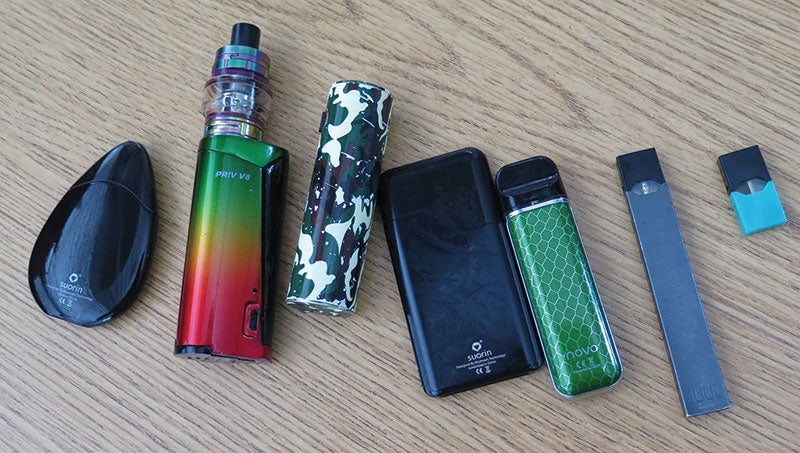‘We’re all behind’: Schools, parents struggle to rein in teen vaping
Published 3:10 pm Monday, September 16, 2019

- Mark Zdechlik/MPR News
By Mark Zdechlik
MPR News/90.1
Vaping worries surfaced in the Hopkins schools about two years ago, but the concerns weren’t driven by parents or teachers. Instead, a student-led health committee came to Holly Magdanz and other district leaders asking for help confronting the issue.
“It really threw myself and the two other staff advisors for kind of a loop,” recalled Magdanz, who coordinates the district’s wellness programs. “We were wondering: Vaping, how big of a deal is it?”
It’s turned out to be huge in Hopkins and districts across Minnesota and the country — a public health problem that many adults did not see coming and are struggling now in homes and schools to keep in check.
It’s mushroomed into a time-consuming disciplinary issue for many school leaders. A recent wave of reports tying vaping to lung damage has administrators and parents even more concerned as the school year begins.
“Parents and teachers and school administrators,” said Magdanz, “I think we’re all behind and we’re trying to catch up.
‘Everybody does it’
E-cigarettes were once viewed as less problematic than conventional cigarettes, still part of the cat-and-mouse games of teens pushing boundaries, but not something to panic about.
That’s changed over the past few years as the vaping industry and the health concerns around it have exploded.
Kya Scholler was 14 when she first bought vaping products online. Her mother, Kyra Hasbargen, eventually found out when a delivery arrived at the family’s home outside of International Falls, Minn.
“I had intercepted a package and opened it up and found a vape thing in there and these juices and I kind of freaked out,” Hasbargen recalled. “I was just like, ‘What in the world is going on? How does a 14-year-old obtain this sort of thing?’”
Kya, now 17, says she’s spent thousands of dollars on vaping equipment and liquids.
“Everyone does it, like even people you wouldn’t even expect that are super athletic and all that,” she said off her Juul, the most popular e-cigarette among young people. It’s black and plastic and looks remarkably like a flash drive. Small containers of liquid containing nicotine fit onto the unit. The Juul is popular because it’s inexpensive, easily concealable and widely available. Kya said it runs about $20 on sale.
Addicted to the nicotine, she said she and her friends got to the point where each was vaping the equivalent of one-and-a-half cigarettes a day. “It like became like my phone where I almost felt lost if I didn’t have it.”
Kya said she recently quit for good because the e-cigarettes eventually sickened her and her friends. She recalled a stretch were she and two other friends were “constantly sick, like a cold sick, from it.”
She also found herself short of breath, with chest pains sharp enough she wore a heart monitor for awhile. Results came back normal, but she didn’t feel normal.
“It was almost like a really sharp pain, like almost like my heart was stopping,” she said.
‘Brain shift’ needed
While Hasbargen is relieved her daughter is no longer vaping, she is beside herself over the issue of kids having such apparent access to vaping materials. She has a younger daughter, Pahtynn, who at 11 years old is nearing the age Kya started her journey with e-cigarettes.
“These companies need to be held liable. These kids keep getting younger and younger and there’s no way for parents to even know.”
Public health officials say a big challenge facing them is countering the widely held notion that e-cigarettes are safe alternatives to conventional tobacco use.
Earlier this month, the Food and Drug Administration sent a warning letter to Juul, telling the company it violated federal regulations by touting its vaping products as safer than traditional tobacco cigarettes.
Education and public health officials agree that the best approach is to teach students and their parents that science does not back up claims vaping is a safe alternative to conventional smoking.
In schools this fall, new anti-vaping posters were up in halls and classrooms. Hopkins students helped design some of them, which the state Health Department made available online.
School districts are holding meetings with parents to teach them about the dangers and prevalence of electronic cigarettes and vaping, hoping adults can do more to spot their use and snuff it out.
Kids as young as elementary students need to be warned about nicotine addiction and vaping, and educators need to do more than police the behavior, said Magdanz, the Hopkins schools’ wellness coordinator.
“In addition to the prevention and the intervention in the schools or homes,” she said, “we need to be openly talking about cessation — kind of a brain shift in terms of not just punishing the kids but really seeing that this is a serious health issue that we to help support them and to get them to stop.”


